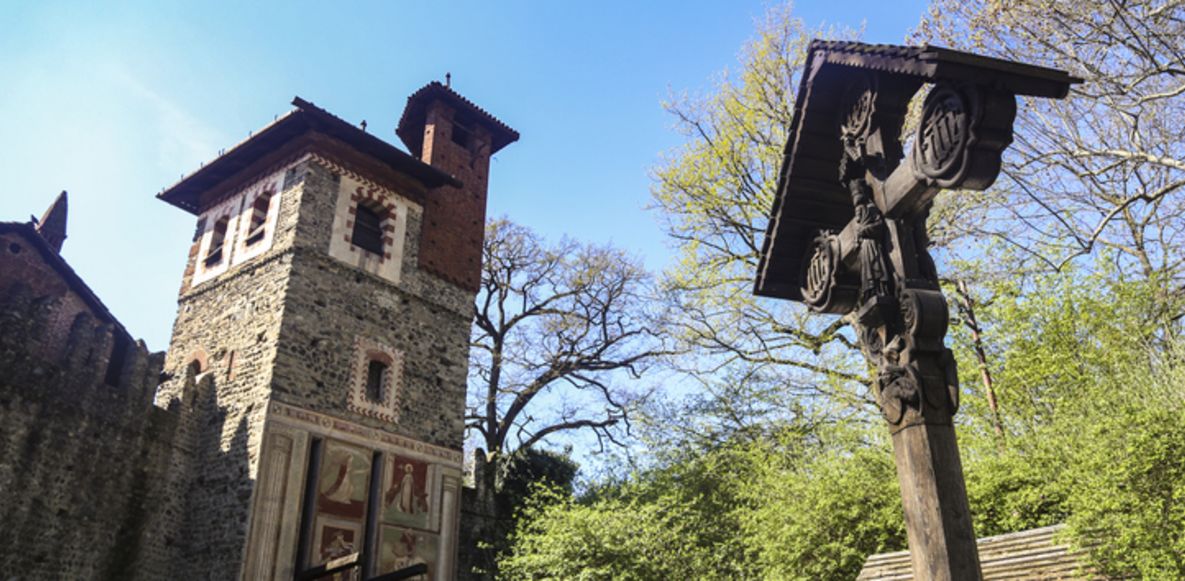Medieval Village of Turin
Built between 1882 and 1884 in the wake of the Great European and American Expositions of the 19th century and based on the idea of the Portuguese architect Alfredo D’Andrade, the Medieval Village of Turin is located inside Valentino Park, a stone's throw from the Po, and represents the reproduction of a true feudal village. Inspired by the architecture of Piedmont and the Aosta Valley, it hosts within its crenellated walls workshops and courtyards, fountains and gardens, towers, medieval dwellings and the imposing Rocca. A journey through time and history that amazes medieval enthusiasts and enchants tourists of all ages.
How to reach the Medieval Village of Turin
The Medieval Village is located at Viale Virgilio 107, near the left bank of the Po. It’s an extra excuse for a walk in Valentino Park because the small inhabited center inspired by the Middle Ages is located right inside it, in the southern area. Both are reachable from our B&B HOTEL Torino Orbassano in just twenty minutes by car or by bus from the Settembrini stop on Corso Orbassano. Alternatively, you can take tram n°10 from Settembrini or the double bus 260 + 299T or 259 + 259S or 74 + 8. Bikes and scooters are private means of transport to rent on a beautiful sunny day to enjoy the charm of Turin on two wheels.
Discovering the Village among workshops, towers and historic houses
Beyond the drawbridge, a typical icon at the entrance of every castle or inhabited center of the era, winds a characteristic zigzag path: it is the Via Maestra that meets seventeen buildings that refer to the architectural style of the 15th century. The list is truly long and interesting: various towers of the city walls, such as the corner round tower, those of Oglianico and Alba, are followed by the Fountain of Salbertrand, the Albergo dei Pellegrini, the first and second houses of Bussoleno, the Porta di Rivoli and the house of Alba with the printing press.
Those mentioned are just some of the first points of interest, to which are added the Church with an exhibition hall, the Rocca, the weapons shed, the Garden of Delights, and the vegetable garden. Numerous artisan workshops of crafts such as the bakery with a blacksmith's shed and a paper mill. A continuum of laboratories, porticoes, monumental facades, and many houses: all to visit like a true journey through time in a village constructed ad hoc in the 19th century.
The Church represented the neuralgic point of the spiritual life of the Middle Ages and could not be missing within the inhabited center. The one reproduced in the Village reproduces the styles and details of various Piedmontese religious buildings: the church of San Giovanni di Ciriè, of San Giorgio a Valperga in Canavese, the parish church of Piossasco, the collegiate church of Santa Maria della Scala in Chieri. Among the frescoes stands out the large Saint Christopher with the Child Jesus on his shoulder, inspired by that of the old church of Verzuolo.
Among the green areas of the Village, on the other hand, emerge the garden of delights, filled with tree species, flowers, rose espaliers and vine pergolas, the garden of simples, rich in humble plants appreciated more for their usefulness than for their beauty, and the medieval vegetable garden which hosts edible botanical species from the 15th century where you certainly won't find potatoes, tomatoes and peppers.
The Rocca of the Medieval Village of Turin
Every city of the era had its main hub in the keep or in the castle of the inhabited center: in this case, it is the Rocca that dominates the rooftops of the Village. Solid and robust, it is inspired by the Turinese style of the castles and the volumes of the Aosta Valley manors such as those of Verrès, Fènis and Montaldo Dora. The fortified residence has within it rooms furnished with furniture and furnishings, embellished with various fabrics, armors, weapons and daily pastimes of the era.
The environments are the regal and popular ones of the fifteenth century: the throne room, the royal bedroom with canopy, the chapel, the oratory but also the great hall of the men-at-arms, the dining room and kitchen. Prisons and the guardian's room could not be missing: the former, dimly lit only by a few candles, house the stocks for chaining prisoners, trapdoors, grates, secret cells and dark pits inspired by the castles of Issogne, Cremolino and Verrès.
Beyond the Medieval Village of Turin
Those who are at the Medieval Village of Turin and want to completely change era and type of attraction can choose two truly different alternatives. The first is a visit to the Automobile Museum in Turin (MAUTO) which traces the historical and technological evolution of the car throughout the 20th century, with clear references to design and human-machine interaction. The second option is sports-related and certainly interests football fans who will be happy to reach the Olympic Stadium of Turin between the Santa Rita district and Borgo Filadelfia: it is the home of the great Toro where you can perhaps watch a home match of the granata.
Beyond the dozens of tourist alternatives, Turin remains the only city in Italy with a Medieval Village that is not original, built in the 19th century but completely faithful to the urban and architectural fabric typical of 15th-century inhabited centers. In practice, an open-air museum.
In short, the capital of Piedmont never ceases to amaze and inspire. Come and discover it, especially in company, and book a fantastic stay at our B&B HOTELS in Turin.



















